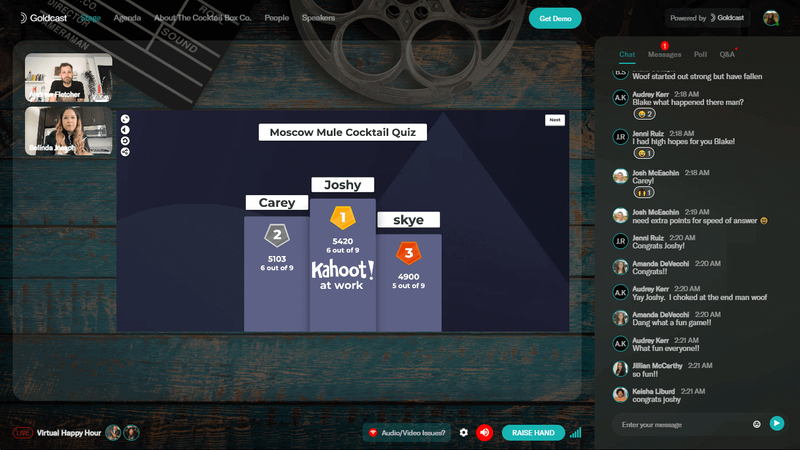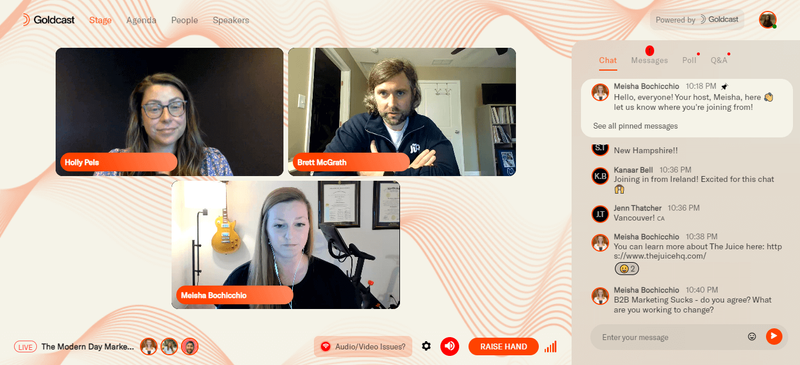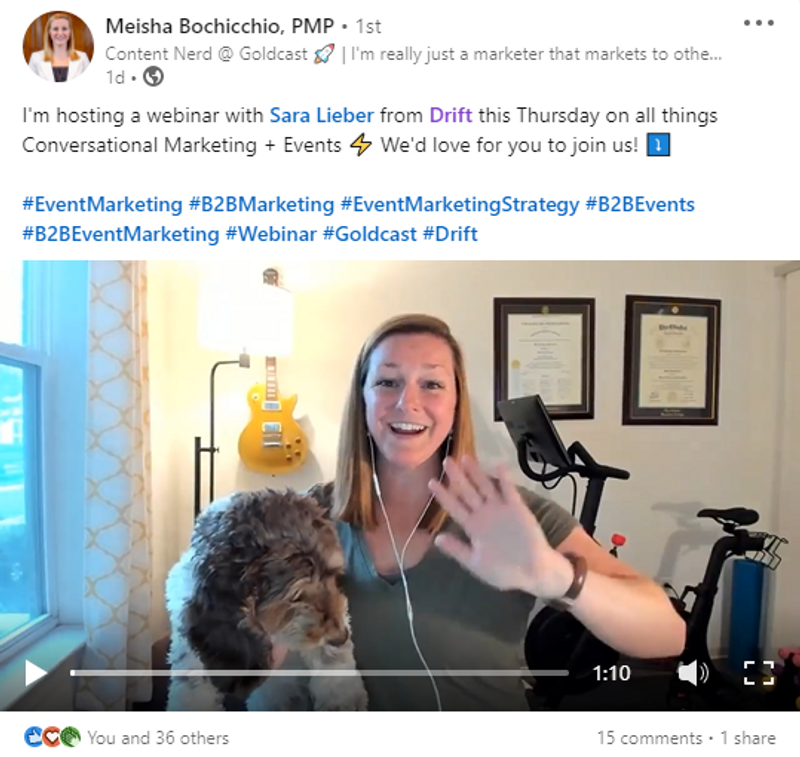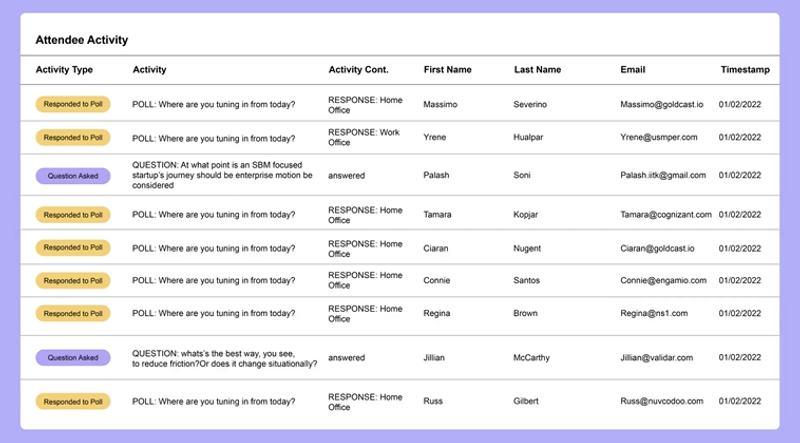Your Virtual Roundtables Are Boring. Here are 10 Steps to Make Them Better.

Table of Contents
Maximize Your Marketing ROI
Join 10,000 other marketers already getting the best tips on running engaging events that boost pipeline and create raving fans.
What comes to mind when you think about a virtual roundtable?
Digging through your email to find a lost Zoom link? Logging into a session with a few speakers that drone on about a single topic? Getting bored after a few minutes and bailing to do literally anything else? And finally, getting bombarded by the host’s sales team right after the event ends for a not-at-all-relevant demo?
We hear you. This is often the experience of 99% of virtual roundtable events—Boring with a capital B… but it doesn’t have to be.
Hosting a virtual roundtable discussion can be an effective way to connect with an audience and drive meaningful conversations. And they can be really engaging and entertaining to viewers if enough thought is put into the event planning and execution.
And that’s where we come in.
Ditch the tired B2B playbook, and dig into this guide on planning super engaging roundtable events that your audience will love. Let’s get to it!
Here’s what we’ll cover:
- What is a virtual roundtable?
- What makes a virtual roundtable “good”?
- 10 steps to planning a super engaging, not-boring virtual roundtable
What is a virtual roundtable?
As the name suggests, a virtual roundtable brings together subject matter experts and thought leaders to discuss and debate a topic. These digital events are made possible by the magic of the internet and the power of a virtual event platform.
Roundtable events feature a moderator. This person manages the conversation and keeps the event moving forward. They don’t actively share their own thoughts but rather ask follow-up questions, keep the conversation on track, and make sure everyone has ample time to share their perspective.
Virtual roundtables have become popular with the rise of thought leadership content in the B2B space. But lately, two major challenges have made it difficult for marketers to run successful virtual roundtable events:
- Most virtual roundtable discussions execute the exact same playbook. It is hard to differentiate between two roundtables because they all look and feel the same, the topics are repetitive, and they swirl around the same narrative. You can’t establish thought leadership by regurgitating something that’s just one Google search away.
- Virtual roundtables often lack direct engagement with the audience. Most treat the virtual audience like a TV audience and completely ignore any opportunity to make them part of the discussion. Even the best speakers can quickly lose an audience if there’s no way to pull them into the conversation.
You can’t expect the audience to turn up if your concept of virtual roundtables still revolves around gathering a few speakers over a Zoom call and hosting a listicle-themed session ( 😴).

If you want to win over your audience, you’ll have to break out of the mold. Virtual roundtables should educate and inspire your audience, leaving them wanting more like the audience waiting for their favorite headliner band for the encore.
What makes a virtual roundtable “good”?
The goal of the roundtable format is to educate and inspire your audience.
More times than not, roundtables follow the same tired playbook and fail to engage the audience. Event organizers prioritize landing impressive speakers with impressive titles over the value that a speaker can deliver.
Let’s be honest—most C-Suite executives have incredibly busy schedules. Organizers might offer these folks a seat at a roundtable because they require very little prep and investment. They simply show up, answer a few questions, and they’re done. This doesn’t often result in much value for the audience.
And most C-Suite leaders are focused on high-level business initiatives. Depending on your audience, folks that are more in the weeds with the tactical activities related to your topic can likely provide more tangible insight.
✅ A good virtual roundtable:
- Has a clearly defined topic that aligns with your audience
- Drives meaningful conversations on pressing topics
- Has a moderator that asks meaningful follow-up questions and ensures that everyone at the table has a voice
- Fosters diversity by featuring an array of speakers from different backgrounds
- Includes participants with different points of view. Each speaker should have different perspectives to offer, and there should be some tension.
🚫 Here’s what NOT to do:
- Ask generic, obvious, or closed-ended questions
- Throw an inexperienced moderator into the ring for their first event
- Source speakers with the exact same ethnicity and background (see also: a panel full of white male executives). Remember, diversity is essential to fostering a productive and enlightening roundtable conversation.
Ok, now that we’ve covered the basics, let’s break down how to actually plan an engaging virtual roundtable discussion. 👇🏼
10 steps to planning a super engaging, not-boring virtual roundtable
In this section, we’ll look at a ten-step framework to help you organize a virtual roundtable that is engaging, informative, and definitely not boring. Let’s go!
1. Define your goals for the virtual roundtable
Different event formats fit across different stages of the buyer's journey.
Since virtual roundtables work best to establish thought leadership and cover emerging industry trends, they are perfect for your top-of-the-funnel (TOFU) marketing goals.
Since the TOFU objectives largely revolve around driving brand awareness, improving engagement, and generating leads, you can tap into a broader audience base.
Next, identify which metrics you will track based on the objectives. For example, if driving brand awareness is your goal, the relevant metrics could be registrations, registration to attendance ratio, session drop-off rate, and session views.

While setting goals, identify what issues you might face and what you can do about them. With attention span being the Achilles heel for most online activities and virtual events, use creative ways to keep the audience engaged till the end of the session.
See how you can incentivize participation. You can also host giveaways and contests combined with gamification to increase engagement and participation.
Important caveat: The audience can smell a sales pitch from a mile away. Therefore, avoid being sales-y at all costs. Focus the session exclusively on engaging and educating the audience.
2. Pick a topic for the discussion
Keep the audience and roundtable goals in mind when deciding on a discussion topic.
You need to know the ins and outs of your target audience. When you know their persistent pain points, you can come up with topic ideas that address those business challenges.
Imagine the appeal behind five experts discussing how the latest industry trend can solve the biggest pain problem. When you identify a topic like this, you’ve struck gold!
While shortlisting a topic, ensure it is comprehensive enough to foster a deep conversation. Identify the multiple angles you can approach it from and what unique perspectives the guests can bring to the table.
Headings like Why Trello Failed to Build a $1 Billion+ Business or Ahead of Its Time, Behind the Curve: Why Evernote Failed to Realize Its Potential promise readers that they will get a perspective that’s never been discussed before. That’s the crux of thought leadership content.
Tips and best practices are a dime a dozen. If you want your buyers to drop whatever they are doing and listen to you, be a contrarian. Pick a topic that goes against the narrative. It's a surefire way to stand out.
For instance, when you read Doomed: Why The Current Model Of Online Advertising Can't Survive, you know you will learn some lesser-discussed aspects of online advertising.
Another caveat: Being a contrarian doesn’t mean being edgy. Thought leadership is built on trust and expertise. Don’t be clickbait-y when picking a topic.
3. Choose a digital event platform
When it comes to any virtual event, engagement is the name of the game. Typical video conferencing software apps work for daily meetings. But for virtual roundtables, you want a platform that actively engages the participants.
When choosing a digital event platform, look for the following three features:
1. Top-notch video production: Nobody wants to see a video with infinite screen freezes, video buffers, and people making robot motions. A platform with studio-grade video production value offers better streaming options and features to play pre-recorded videos and zillions of other features.
2. Engagement tools: Virtual roundtables are more interactive than, say, webinars. There’s a lot of back and forth between the moderator, speakers, and attendees. Therefore, the event marketing platform must have engagement features.
The moderator can keep a tab on the live chat to see what attendees are talking about. Similarly, the moderator can create a series of polls to boost engagement during the session. Attendees can ask questions via text and video Q&A features. Fellow attendees can upvote questions so the moderator can include top-voted questions in the discussion.
For next-level engagement, look for a tool that supports virtual networking so that attendees can connect with each other during and after the discussion.
3. Integrations: The virtual event platform should offer integrations with third-party tools like marketing automation platforms, CRMs, and registration platforms. Although you don’t expect a sale to happen during these sessions, integrations with these tools let you transfer attendee data into your sales and marketing platforms for lead scoring and nurturing.

4. Invite the right speakers
The success of your virtual roundtable depends on how good the moderator and speakers are. And the criteria for selecting both are similar but different.
The moderator is part emcee, part interviewer, and part prober. They must have experience in facilitating virtual roundtables. They should know how to engage the audience and speakers so that the discussion doesn’t become dull.
While it isn’t necessary for the moderator to be a subject matter expert, understanding a good deal about the topic helps. Also, being a recognized face in the industry is like the cherry on top.
The ideal number of speakers is between four and six. The speakers are the headlining act, so look for well-known figures in your niche with prior speaking experience.
When shortlisting speakers, consider their work experience, online presence, and audience. Having a similar audience will allow the speakers to establish a connection with the attendees and vice versa. Also, ensure that speakers are passionate about their topic and are super comfortable on camera.
The most important part is to ensure that the panel represents diversity. Include speakers from different backgrounds, genders, races, and ethnicities. Diversity is how you bring in varied perspectives and foster meaningful conversations. If you end up shortlisting a panel representing all-white male speakers, you’re missing the mark.
Finally, look for speakers with views on extreme ends of the spectrum and one somewhere at the center to get balanced viewpoints.
5. Prepare a list of questions for the moderator to ask
Inviting speakers with extreme viewpoints can turn into a heated discussion. Can you imagine a composed person like Seth Godin almost walking out on Gary Vaynerchuk’s podcast? (Yep, that happened. Check out ~24:00 for the golden moment)

The moderator should be an expert at balancing the yin and the yang of a conversation. Knowing how to bring a heated conversation to normalcy is an art, and you would benefit from having a moderator who can do that.
Get the audience involved early by soliciting questions on your event registration form. This is an easy way to ensure your conversation connects with attendees.
Also, do some research to come up with your own questions. Shortlist the FAQs and share them with the moderator so they know how to navigate the discussion.
Pick controversial topics and questions so that speakers can share their views and there’s scope for a healthy debate. Treat each question as a storytelling prompt with a scope to create enough conflict before resolving it. That’s how you fire up the audience!
6. Promote your event early and often
You can’t have a roundtable without an audience, so you’ll want to spread the word early and often.
Email is often the most effective channel for reaching a warm pool of potential attendees. Segment your database by things like title, industry, etc. to create an invite list of the most relevant audience.
Social media can be an effective channel for generating broad awareness for your roundtable. Stick to the channels where your audience spends the most time (for B2B marketers, that probably includes LinkedIn and Twitter) and use engaging visuals to stand out on the timeline.
To really stand out from the crowd, have your moderator or panel participants create a short video personally inviting folks to join. Then, share the video via email, social media, and anywhere else you’re promoting the event. This small, personal touch can create an instant connection with your audience and entice them to register. Check out this example from a recent webinar promotion.

Finally, getting folks to register for your roundtable event is just the beginning. You also need to make sure they show up on the big day! Here are three ways to increase your event show rate:
- Eliminate the friction of joining an event by using magic links ✨ These single-click links are the easiest way to join an event!
- Look for an event tool that sends automatic calendar blocks for an event. This way, your roundtable event stays front and center.
- Be sure you have a few reminder emails scheduled to drive folks into the event. Ideally, these will include the personal magic link for easy access.
7. Host your virtual roundtable
Begin with the roundtable discussion by providing a brief rundown of the agenda. The rundown should address the topic, panel members, questions you will cover, and ground rules. You should also make sure your moderator is prepped with the roundtable questions and a general run-of-show outline.
Remember, following a discussion in a virtual setting, even for just a few minutes, can get taxing for viewers. Eliminate the monotony by incorporating audio snippets, video clips, or other visual media into the discussion.

Ensure that the moderator keeps the session on track and steers the discussion in a productive direction. You can use the live chat feature of the digital event platform to communicate with the moderator and other speakers as needed.
Lastly, don’t forget to engage the audience directly throughout the session via interactive tools. Prepare a set of questions and polls to ask the audience based on the topic. Encourage the attendees to participate in the discussion through the Q&A tool. And if your platform allows, ask them to participate via the video Q&A tool. It sounds like a trivial thing, but this personal touch improves the overall event experience.
Considering the discussion can get polarizing, create polls and survey questions to understand what the audience thinks about the topic.
8. Follow up with event registrants
Hooray! You’ve crossed the finish line and just wrapped a successful virtual roundtable. But just because the cameras are off doesn’t mean the work is over.
The most pressing post-event action item? The follow-up.
Don’t leave folks hanging after the event. Registrants often expect at least a recording of the event, though there are lots of other ways to provide value.
Instead of just sending the recording, give folks a few highlights with an event recap.
For example, at Golcast, we host an interview series titled Event Marketers Live. After each session, we upload the video for easy on-demand access and create a blog of high-level interview takeaways for folks to peruse at their convenience.
Look for other resources on the roundtable topic that could also be interesting or helpful to the audience and include those in your outreach. Or, share related content from your roundtable speakers.
If you have the bandwidth, segment the attendees by their attendance status and personalize the emails.
9. Measure roundtable success
What’s a virtual event without proper post-event analysis?
Look at the metrics you set when defining your goals and see how the virtual roundtable performed against them.

Some key event metrics include the number of registrations versus the number of check-ins, event participation time, audience questions, and chat engagement.
Dive deep into the Q&A session and poll/survey data to unearth unique insights. You can use this information in your content and while planning future events.
Also, consider collecting feedback with a post-event survey to gather qualitative feedback that can be used for future events.
Ditch the boring for your next virtual roundtable
“And with great thought leadership come more leads.” - Benjamin Franklin… Not.
Virtual roundtables are an effective way to connect with your audience and establish your brand as a thought leader. However, a boring roundtable is a connection killer.
Traditionally, roundtable meetings are known to be very serious and formal. And while they can be professional and information-dense, they definitely don’t have to be boring.
Try our tried-and-true framework for your next virtual roundtable event!

Stay In Touch
Platform
Resources
Company
Community
© 2025 Copyright Goldcast, Inc. All rights reserved.



 Upcoming Events
Upcoming Events Event Series
Event Series On-Demand Events
On-Demand Events

